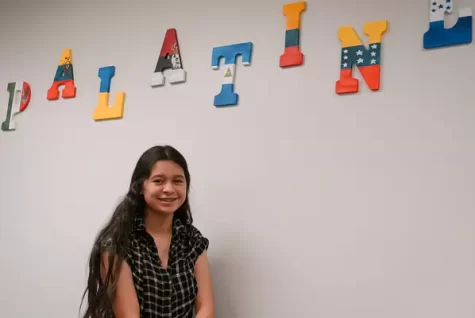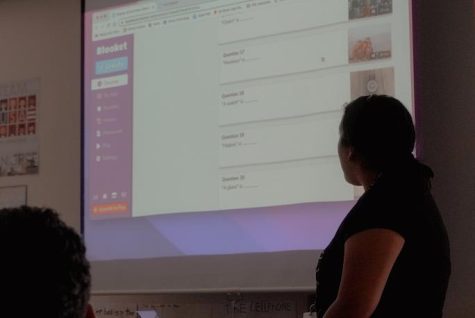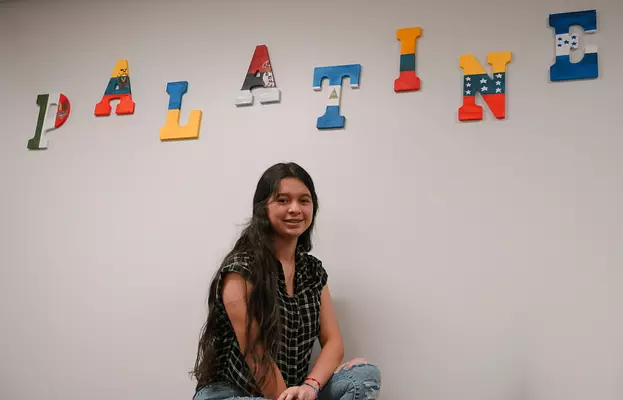El Departamento de EL
February 16, 2023
Students bustle around Chelsis Alarcón-Tercero in the gymnasium, walking confidently to their seats. She can’t help but feel intimidated at how skillfully they can speak with each other, while she can barely discern a word. Armed only with a dictionary, Alarcón-Tercero takes in a deep breath and prepares for the one of the hardest tests of her life.
Alarcón-Tercero isn’t taking a foreign language exam, she’s taking the SAT. Coming from Nicaragua, she’s been in the English Learner department in order to improve her English- but she’s challenged by more than just the curriculum.

Coming to America
“It was hard to leave my family in Nicaragua,” Alarcón—Tercero said. “I wasn’t thinking much about myself, I was thinking about my mom and leaving her there.”
EL students make up 18.7% of Palatine High School, and many of them had to leave their home countries behind in search of better opportunities. Alarcón-Tercero is one of these students, and having to leave her mother behind wasn’t even the most difficult part.
“One of the things I had to do was sit in a trailer for almost 16 hours,” Alarcón-Tercero said. “Then I had to walk through a river that went up to my waist. It’s scary because you don’t know what’s going on [in the water].”
Arriving here doesn’t make things any easier. EL students often have to work with their parents. For example, Alejandro Morales began working when he was eleven years old.
“I started out by just helping to move bricks around,” Morales said. “When I got here, I began doing more intense construction and actually helping put things together.”
Now sixteen years old, Morales continues to work in the construction business while juggling his school work. When he had to catch himself up at the start of the year, he relied on unorthodox methods to keep up.
“Initially when I came here, I couldn’t understand a lot of the math,” Morales said. “So I told my cousin back home to send me his notes, which were in Spanish, to help me understand.”
EL students come in with a variety of stories, and all of which don’t come to an end just because they’ve arrived in the United States. They continue to persevere through the challenges that arise from their upbringing and the language barrier it creates.
“I’m still trying to adjust to all the changes,” Alarcón-Tercero said. “And sometimes I regret coming here. But I had to so I could have the opportunity to help my family back home.”

Two homes, one building
Many students may not get the chance to hear these stories because of how separated EL students and English proficient students are. There’s little interaction that takes place between the two of them. The EL department is situated on the third floor of PHS, isolated from its math and science neighbors.
“I really only see English-speaking students when I’m in my math or gym class,” Iryna Rabcheniuk said. “People who come here for the first time, they don’t know anything about the regular classes because no one speaks to them about it.”
This separation from the rest of the Palatine community draws the EL students inward into their own department, where they form deep connections with one another.
“They feel like this is their family, their class, and sometimes their classmates are their family,” EL teacher assistant Jennifer Cardenas said. “They see each other almost 40 hours a week, so they’re very tight knit.”
As important as these connections are to making Palatine more of a home for them, it can still hurt these students academically when the only connections they do have are within the department and not with other students or staff.
“They spend a lot of time together, which is good.” EL teacher Marisela Gonzalez said. “They build a little family, but that kind of excludes them from all of the mainstream stuff.”
Some EL students are integrated within English proficient classes, typically math or P.E., and this exposure has been met with positive responses.
“Whenever I’m in classes with Americans, I feel like I’m integrating more into the school,” Alarcón-Tercero said. “I’m not just with other people who just speak Spanish.”
Those who haven’t had that exposure are aware that it exists, and express a desire to experience that for themselves. When surrounded by Spanish for most of their time in EL, they feel their English will improve if they’re surrounded by that instead.
“I would like to be mixed with other students who speak English,” Diana Melende said, “Because my friends here don’t speak a lot of English.”
InACCESSible

Keeping students from fully integrating into English-proficient classes is the ACCESS test, which comprises four sections: speaking, writing, reading and listening. It’s meant to evaluate an EL student’s proficiency in English, however its format can be difficult for students to grasp if they aren’t already used to it.
“A lot of our students are not used to the standardized testing setting,” Gonzalez said. “So they don’t know what to expect.”
The ACCESS test not only influences student placement, but is also keeping an EL student in or out of the department. Without passing it, students would be required to unnecessarily pay for EL classes going into college. The stakes are as high as the SAT, yet the majority of the school would never know it’s ACCESS test day unless they saw it for themselves.
“Unlike the SAT, the school doesn’t shut down for ACCESS testing,” Gonzalez said. “The school is still running while the kids take the test, and it’s not the best setting for them.”
Heroes in our midst
EL students have many challenges to overcome, but the EL department is dedicated to giving them the support they need. With 13 teachers and 39 teacher assistants help comes in many ways.
“I’m not making up that they’re awesome or anything,” one Level 4 student said. “I literally just want to say that they are great people that help with everything.”
One of the biggest supports that EL students have are teacher assistants who supplement their learning and work individually with students who are struggling. More often than not, however, their responsibilities require them to go above and beyond.

“They can technically be considered teachers too, like full on teachers,” EL teacher assistant Jennifer Cardenas said, “They’re teaching lessons, complete lessons.”
Not only do teacher assistants help teach, but also give one-on-one attention to the students in their class, to help them grow more comfortable around staff.
“Teacher assistants most oftenly bond with the students,” Cardenas said. “They do a lot of one-on-one so they really get to know them.”
Teacher assistants give the EL students a connection to the school they may not find elsewhere. In spite of their efforts, these teacher assistants can’t help everyone all at once. Their one-on-one time with students means some don’t get the attention they need.
“We have like 25 kids [in EL math and science classes], it’s three people for 25 kids,” Cardenas said. “And almost all of them need help. Some students always need someone to be there.”
Without inter-departmental and student understanding, the EL staff finds it difficult to help 18.7% of the student population
“They know the math, they know the science,” Gonzalez said. “They just know it in their language obviously. So if there were more options for bilingual classes that would be better for them.”

Creating more bilingual classes is an optimistic goal, but without enough bilingual teachers to begin with, it’s impossible. EL teachers have to instruct their own classes, and taking them away from there will reduce support in the EL department.
“If there are 15 students that speak a certain language, a bilingual class needs to be created for them,” Gonzalez said. “But that’s not the case here because there’s no teacher.”
Although the staff of the EL department have difficult work, helping their students make progress motivates them to never give up.
“It’s very fulfilling when you see progress,” Cardenas said. “Because you know that you’ve contributed to mass growth, it’s not small growth.”
The EL department thrives off help, and that help doesn’t exclusively have to come from within the department. They are seeking understanding from both students and staff. They may not be seen as often in the school, but they exist all the same.
“It starts by not ignoring this group,” Gonzalez said. “You have to take them seriously and understand that they are very capable and learning new things every day.”
“It comes down to the little things, like saying hello to them,” Cardenas said. “I’m almost talking about it as if it’s two separate homes. We need to make it one home.”

